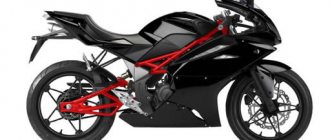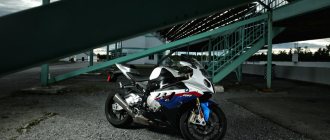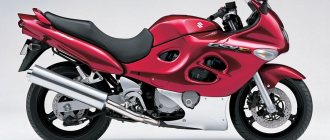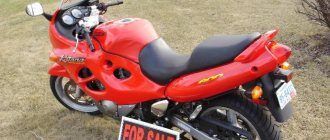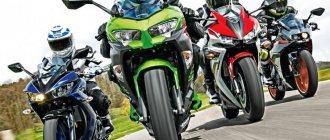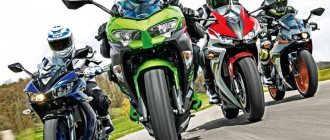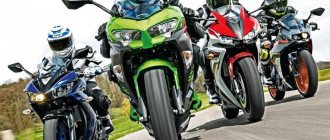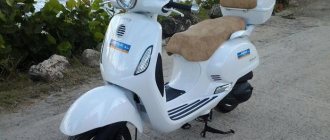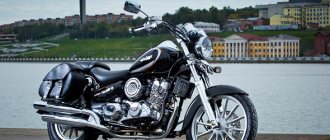Japanese motorcyclesSuzuki motorcycles
At the end of the 70s, when Japanese motorcycles, mainly produced at that time in the “road” class, had become somewhat boring in the world, they were not yet producing sports bikes, and motorcycles in the “American” style were just emerging, it was necessary to come up with something new .
And the Suzuki designers found a way out by turning to the German company Target Design for help in designing some special motorcycle.
The Germans did not refuse help, and taking as a basis the then flagship of the Japanese motorcycle manufacturer, the Suzuki GSX-1100 model, and on its basis they designed the Suzuki GSX-1100 F motorcycle, the word “Katana” was added to the designation of the model name.
Equipped with an 1100 cc engine, the Katana was for some time the most powerful motorcycle in the world.
A little later, “Katana” bikes with other engines were released, but the motorcycles never became a separate series; they were all part of the GSX series.
As part of this line, “Katana” was produced until 2008 .
general description
The “Katana” line belonged to “sport tourers” and included motorcycles with engines of 400, 600, 750 and 1100 cc. cm.
The most popular of all these bikes was the 600 cc version, but the “long-lived” is the 750 cc motorcycle , which was produced until 2008.
In fact, the first “Katanas” were “road bikes” equipped with plastic sports body kits, which led to them being classified into two classes of motorcycles at once.
But this did not initially apply to the 400 cc version, the first models of which were ordinary “road cars”.
Only with its appearance after the first modernization, which took place in 1983, did this motorcycle become similar in appearance to the rest of the Katanas.
Until the 90s, these motorcycles had a classic road layout, with an open engine, a high tank and a straight seat.
An angular fairing with a small glass was installed in the front of the motorcycle.
But since the beginning of the 90s, the appearance has been revised. They began to look more like sports bikes .
The power plant of these models was already completely covered by fairings, the seat, together with the rear wing, was already located at an angle and had a stepped shape. The angular shapes in the appearance of bikes have disappeared .
Additional accessories
Optional accessories allow each rider to personalize their Suzuki Katana to suit their individual preferences.
- Wind deflector (tinted)
- Colored seat
- Carbon Clutch Cover / Carbon Crankshaft Cover
- Colored Brembo calipers (red) / Axle sliders
- Carbon front fender
- Wheel rim stickers
- Set of stickers for motorcycle body
- Heated grips / Carbon accessories / Protective sticker on tank cover
- Side protection stickers / Anti-slip tank sticker / Textile tank bag
Motorcycle design
"Katana" was equipped with 4-cylinder power plants with an in-line arrangement.
The engine was cooled by either air or air-oil cooling.
The power supply system is carburetor only. Power indicators depended on the working volume.
Otherwise, the motorcycles were similar in appearance , since the same design solutions were used.
And there was no point in selecting anything special for a specific model.
These motorcycles have proven themselves to be reliable road bikes with good sporting capabilities.
To describe the Katan design, let’s take modern models. These motorcycles used a twin aluminum frame.
The front suspension consisted of a telescopic fork, while the rear suspension had a pendulum design with a monoshock absorber.
The brakes on motorcycles are only disc , but two discs were installed at the front and only one at the rear.
The motorcycle's plastic body kits consisted of several parts. The front part is the most voluminous, it covered the front of the motorcycle and dual headlights, glass and turn signals were inserted into it.
Also, this part of the body kit covered the upper part of the engine and extended to the seat, but the tank remained open . The lower part of the power plant was covered by the second part of the body kit.
The third part of the plastic body kit, the rear one, went under the seat and covered the frame. An exhaust pipe was installed on the right side of the motorcycle, and the drive chain was open on the left.
In addition to its simple and reliable design, the Suzuki Djebel 200 has another advantage - its low price, which ensures its popularity even now.
And in this article we review another budget motorcycle, which will be an excellent option for a beginner.
Advantages and disadvantages
Since the motorcycle was designed as a budget option, it did not receive any special distinctive features. In addition, representatives noted that they were afraid to change the model too much, since either the price would increase or the bike would not be able to be considered a “universal soldier.”
In general, the motorcycle can be called friendly, but still requires certain driving skills.
But at the same time, users noted:
- efficiency and large tank volume;
- consumables are not a problem;
- but large parts have to be ordered from Japan;
- problems with standing on the side stand - you can fall off it even from a sideways glance, but if you slightly reduce its length (an angle grinder helps), the problem is solved;
- prone to wobbling , so letting go of the steering wheel, even temporarily, is highly not recommended;
- Excellent maneuverability - even with a passenger you can make a turn under the knee.
As those who have had time to sit say, it’s a good and balanced bike for long trips , and not for layovers.
Model specifications
Regarding the technical characteristics, they will be given only for the two most popular models - GSX-600 F and GSX-750 F.
For these models they are:
| Characteristics of Suzuki GSX F Katana | |||
| Parameter | Unit change | GSX-600 F | GSX-750 F |
| Length | mm | 2140 | 2140 |
| Width | mm | 755 | 760 |
| Height | mm | 1195 | 1190 |
| Seat height | mm | 780 | 790 |
| Weight | kg | 208 | 209 |
| Wheelbase | mm | 1470 | 1465 |
| Clearance | mm | 120 | 120 |
| Engine | type | 4-cylinder, in-line, | 4-cylinder, in-line, |
| Volume | cube cm. | 600 | 750 |
| Power | hp | 80 | 93 |
| S-ma cooling | type | air | air |
| S-ma nutrition | type | carburetor | carburetor |
| Since launch | type | email starter | email starter |
| Transmission | type | mech., 6-speed, | mech., 6-speed, |
| Drive unit | type | chain | chain |
| Tank | l | 20 | 20 |
Suzuki Katana
On the road, you'll immediately appreciate the Katana's agility and friendly demeanor. The responsive cornering response of its compact, lightweight chassis inspires confidence and pure pleasure. The seat and optimized position are designed to improve handling, giving complete comfort on long trips. This gives you the confidence to travel all day, day after day. The power of the Suzuki Katana is optimally balanced with handling, ease of riding and pure pleasure for the soul. The Suzuki Katana feels like a magnificent natural extension of the rider's intentions and spiritual needs.
Suzuki Katana
Estimated cost
Long-term production without any special changes made to the technical part of these motorcycles led to their not very high cost .
And although “Katana” is not currently produced, there is a secondary market for these models .
For these motorcycles, the price depends on the year of manufacture, the installed power plant, as well as the condition of the bike itself, and the cost varies from 90 to 250 thousand rubles .
This article reviews 10 models of children's battery-powered ATVs, their advantages and characteristics.
No less popular and diverse are these motorcycles designed for children. Description and characteristics in our publication.
The range per refueling is only 130 km!
The passenger will have nothing to complain about. Although he will have to pull up his knees a lot because the footrests are screwed down tightly, the wide sofa is so comfortable that distances well beyond the distance from the house to the pub will not be a problem. By the way: don't be surprised by the fairing. It is small and does not protect the head and shoulders from air pressure. It becomes a nuisance from 160 km/h.
The new Katana loses the agility of a sports car, but improves ride comfort.
The Katana's biggest drawback? It has a tank capacity of only 12 liters. That's 5 liters less than the GSX-S 1000 and 9 liters less than the '80s Katana. It is clear that new motorcycles are more economical, but this is too much. A fully fueled Katana will travel about 180 km. Want to go fast? At the gas station you will find that 8.6 liters of fuel flowed through each injector for every 100 km. This means a microscopic range – only 130 km!
Photo gallery
As we have already found out, Suzuki Katana motorcycles are reliable road bikes with good sporting abilities. This selection includes models with different engine capacities and years of manufacture. Thanks to this, you can trace how their appearance has changed over time.
Modifications
The developers did not get carried away with modifications of the model; they limited themselves to the fact that after the change of generation, the dimensions of the motorcycle changed in all respects.
and competitors
Yamaha FZR 600.
Honda CBR600F.
The model did not arouse interest among competitors either. The first to introduce an equivalent replacement was Kawasaki, offering its GPX 600 .
Noticing his gesture, other Japanese also introduced sports:
- Yamaha has fielded the FZR 600;
- Honda - CBR600F (first generation).
Power point
- The engine is petrol, four-cylinder, in-line;
- cylinder volume, working - 599 cc/cm;
- compression - 11.3;
- cooling - radiator, air-oil;
- food - carburetor;
- ignition - contactless, transistor;
- power - 78 hp at a rotation speed of 10350 rpm;
- torque - 54 Nm at 7950 rpm.
When I first saw the teaser of the Suzuki GSX1100S Katana, I was hooked because, despite not being a fan of street bikes, I love bikes with historical references and continuity. As for this Japanese, his ancestor has a very interesting history. In these days of total globalization, it is difficult to surprise anyone with the fact that the appearance of the modern Katana was shaped by the Italians, who traditionally cope well with this issue. At the same time, I managed to notice that many people consider this design controversial and its assessment varies from the wording “ugly” to admiring “wow”. With its predecessor, everything was very similar. When the world saw the Suzuki GSX1100E in 1979, quite a few media representatives predicted the failure of a motorcycle with such sharp contours. In fact, everything turned out exactly the opposite: Suzuki made a splash, and the American magazine Cycle World awarded it the title “Superbike of the Year” for three years in a row. Katana acquired these most characteristic contours... thanks to the work of ex-head of BMW design department Hans Muth. It was his company, Target Design, that dealt with the Japanese style. And yet, the relevance of the radical appearance did not last long. A few years later, interest in such a delicacy subsided, which did not prevent the motorcycle from gaining the status of a legend.
However, Katana became famous not only for its appearance. In fact, it helped the company finally recover from some crisis that Suzuki found itself in in the mid-70s, relying on a rotary engine. The GSX1100E became the company's first large four-row bike, which was declared as the fastest production bike in the world.
A modern interpretation of the Suzuki Katana is a motorcycle built around a redesigned liter engine of the famous Suzuki GSX-R1000. In fact, this is a kind of stylization of the “jixer”. The bike looks like a real ascetic compared to most of its competitors from other brands, which makes it feel special. For example, you will not find a quickshifter in it, which these days is installed everywhere, without regard to class and necessity. The instrument panel, although liquid crystal, looks a lot like the screen of a game console with Tetris in the early 90s: the pixels here are deliberately not smoothed even in the Katana logo. In general, they do their best to make it clear that underneath you is a real bike, the impression of which can only be spoiled by the same exquisite color animation.
My test subject is quite light on paper - 215 kg, but in life it feels like a real bicycle. Its weight distribution and ergonomics are at the highest level, whether static or in motion. This fact allows you to cut through traffic jams with a high degree of comfort and feel great on turns. In general, while riding, I couldn’t shake the feeling that the motorcycle was moving on some kind of monorail, all the trajectories were so stable at different speeds. 150 horses and 108 n.m. torque, as if in themselves, imply that the motorcycle does not lack power. Around the city, restraining yourself and carefully observing traffic regulations, three gears will be enough for you, since starting is not particularly impressive, and for the first time having the opportunity to look at the speedometer, you will usually already see 100 km/h. Considering the potential that the engine carries, the bike cannot be called jerky: it does not torment you with jerky jerks, and its three-level traction gives you a choice of riding style.
And here I have to shake the fearfulness of this Suzuki. Back in the SV650 review, I wrote about the Suzuki Low RPM Assist System. It is also present in Katana and, in my opinion, this is a real must have for all modern motorcycles. I’m perplexed why such an assistant is not universally installed on other bikes. Let me remind you that the essence of the system is that at low speed the engine slightly increases speed. As a result, you are practically deprived of the opportunity to stall at the start, or in a stretch, where you force the clutch less. Cutting through the next traffic jam, you can forget about the gas handle and clutch trigger, drive 16 km/h, slowing down slightly in the necessary places, and the motorcycle will not twitch convulsively, trying to stall. This feature alone makes the motorcycle incredibly user-friendly.
The seating position is very comfortable for this class: a slight forward tilt, but the arms are not overloaded. The attitude towards the legs is also loyal, in any case, my operated knee did not complain, but it can. They didn't take much care of the passenger here, but it was tolerable. The characteristic square headlight shines perfectly...
Of these, I would note the rather harsh clutch, which makes itself felt in very dense traffic jams. Not everyone likes the rear wing with a cantilever mount on the pendulum, but it seems to me that this solution perfectly relieved the load on the tail section, making it elegant. I’ll write this about the gearbox and brakes: you just don’t pay attention to them and this is not the worst characteristic, in my opinion. Even on the third day of the test drive, a question about them would have taken me by surprise. And all because you just go, use it and you have enough of everything. Brembo cars? Well, okay. Anything standout to get their attention? No. But for you to feel at some point that they are missing - also not. Something like this.
The sound of the “Jixer” exhaust could have been patented long ago, and the throttle changes when downshifting are extremely pleasing to the ear. Perhaps some aesthetes will try to change the can in Katana, but in my opinion this would be a perversion. Besides the fact that it sounds great (it’s unclear how Suzuki squeezed it into European standards), it also looks very harmonious. In general, the GSX1100S is one of those rare motorcycles in which it is not so easy to change something without it looking like a collective farm. For myself, I only noted the mirrors that look too cheap. Otherwise, this is a very complete machine, which for the author has become one of the most fun motorcycles of this year. And everything is really cool... if not for the 12-liter tank, which, with a consumption of 6 and a penny liters, will make this bike the most popular guest of all gas stations in the area.
A new “sword” in old traditions
The Katana was introduced in 1980 at the Cologne Motor Show. The manufacturer closes the time loop by making an obvious update of the original source according to the same principle. As in the 80s, an independent designer invited by Suzuki took up the work.
Italian specialist Rodolfo Frascoli, who is already known for the Griso Moto Guzzi, Norge and Stelvio, Triumph Speed Triple, as well as the Tiger 1050, has worked on the Suzuki GSX-S1000. Note that the base is again based on the Suzuki GSX-S1000! The project was developed jointly with engineer Alberto Strazzari.
The Suzuki GSX-S1000 motorcycle is praised and recognized as worthy of the basis of a new legend and is even considered an underrated bike. Indeed, the company is simultaneously repeating and rewriting the history of its favorite model.
Much in common
The new Katana uses a modified version of the 2005-2008 GSX-R1000 four-stroke liquid-cooled inline engine, making 999cc and nearly 150 horsepower. The long-stroke engine houses lightweight aluminum pistons and rings created using finite element analysis, making them rigid and resistant to external influences.
To ensure smooth and controlled engine response, the engine is equipped with a special throttle control mechanism.
The power unit is located slightly lower, which stabilizes the motorcycle in motion. The 4 into 2 into 1 exhaust system is made of stainless steel for less noise when gases are released from the engine. In the middle of the pipe is the Suzuki Exhaust Tuning valve, it controls flow into the catalytic converter and exhaust chamber to balance performance and emissions control.
The six-speed transmission has vertically stepped shafts, as in the sport versions, to reduce the overall length of the engine.
